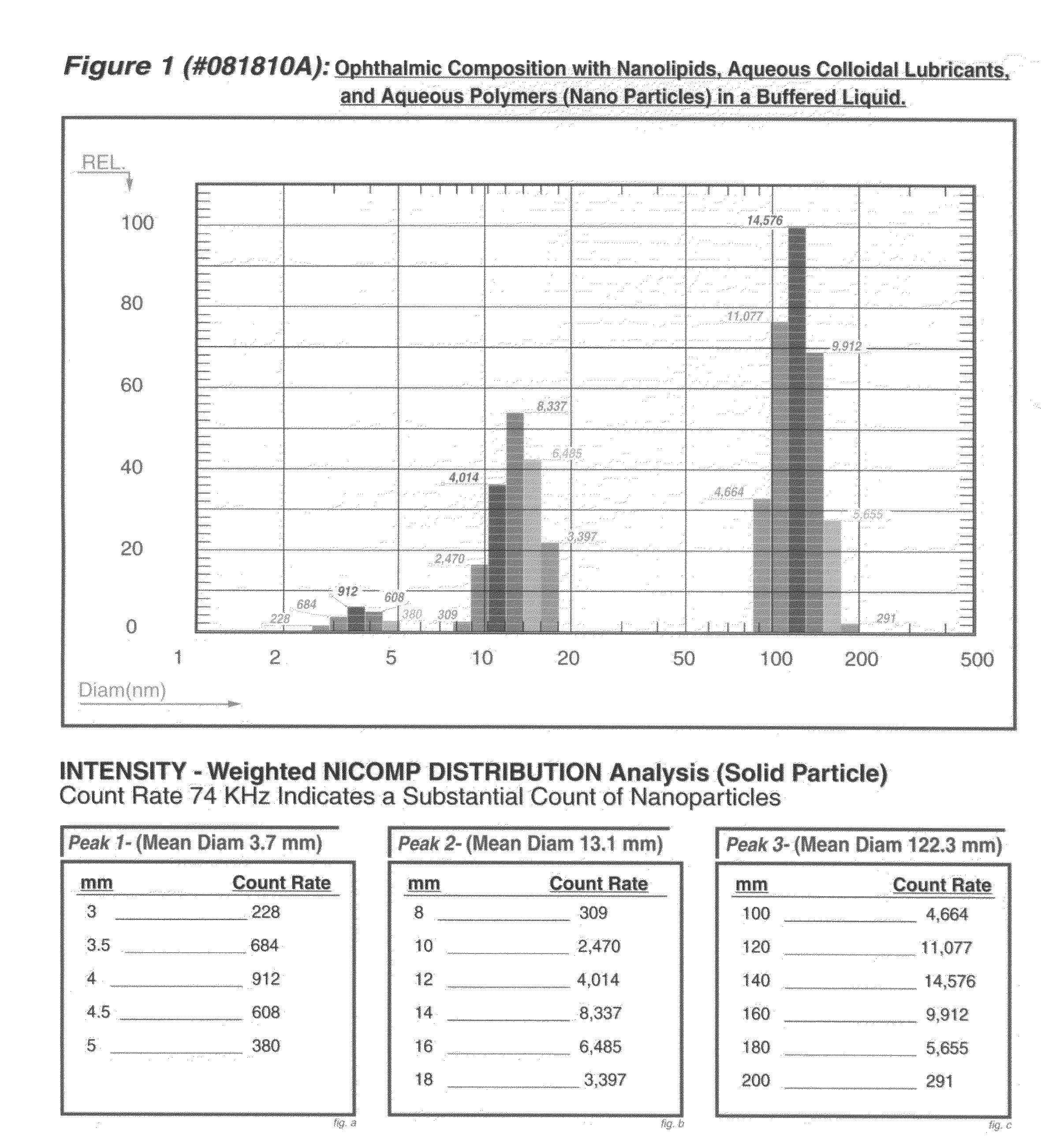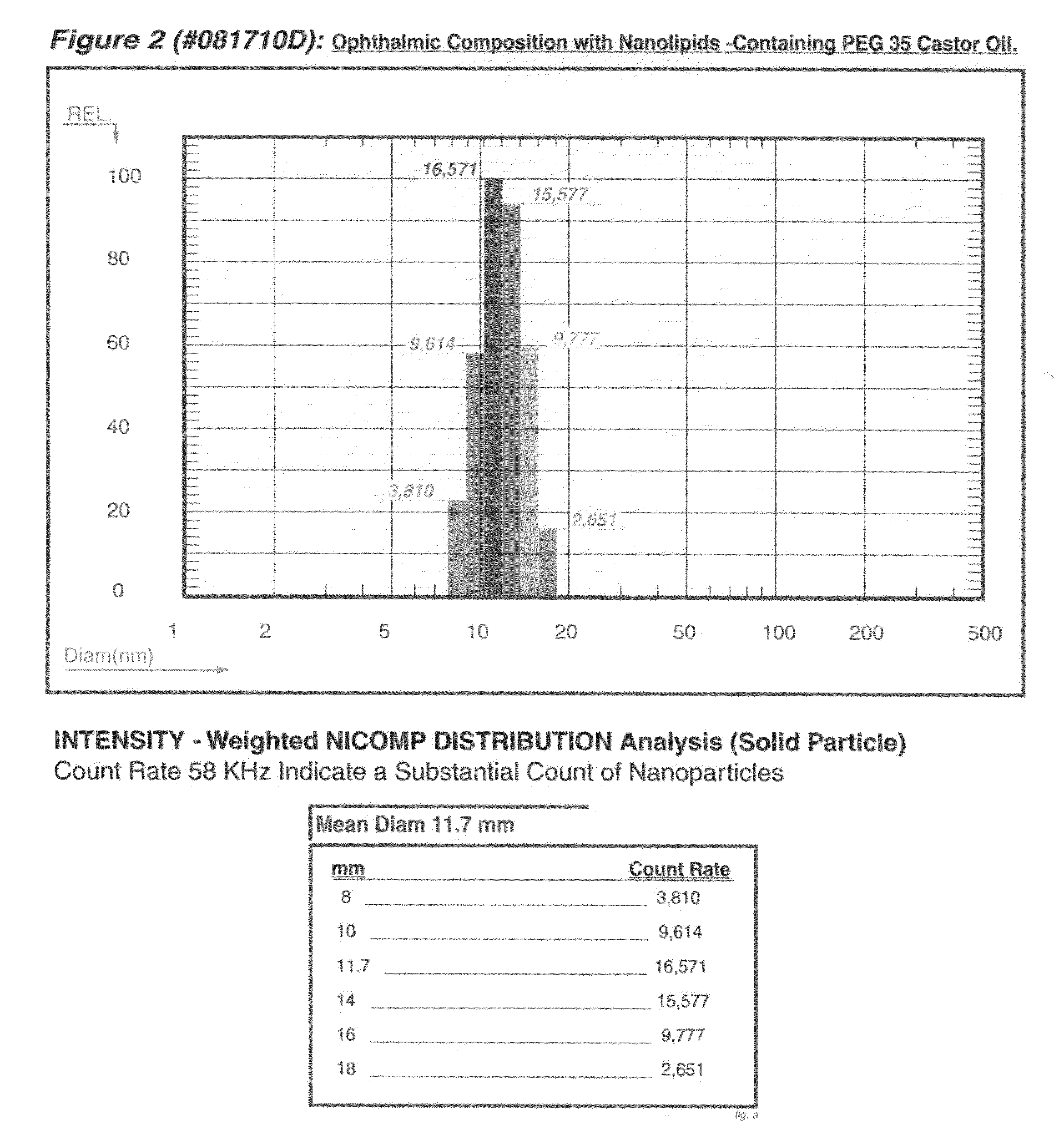Composition for a topical ophthalmic clear colloidal liquid which undergoes a liquid-gel phase transition in the eye
a colloidal liquid and liquid phase technology, applied in the field of colloidal liquids which undergo liquid phase transition in the eye, can solve the problems of eye dryness, irritation, increased symptoms, etc., and achieve the effects of restoring and maintaining a healthy outer lipid layer, prolonging delivery, and negatively affecting vision
- Summary
- Abstract
- Description
- Claims
- Application Information
AI Technical Summary
Benefits of technology
Problems solved by technology
Method used
Image
Examples
example i
[0035]Topical ophthalmic composition containing nanolipids and other lubricants.[0036]Phase I: compound amount (w / v) Gelrite ‘Gellan Gum’ 0.1%, polyvinyl alcohol 0.5%, hydroxyethylcellulose 0.3%, povidone K-30 2.0%, PEG 35 Castor Oil 1.0% and purified water q.s. to 80%. While mixing add the above items while maintaining a temperature of 85° C. ±5° C. until completely dissolved. Transfer to a pressure tank and autoclave at 121.1° C. for 45 minutes, the cool down to 25° C.
[0037]Phase II: compound amount (w / v) of Boric Acid 1.12%, trimethamine 0.65%, Glycerine 0.5%, propylene glycol 0.3%, polysorbate 80 1.0%, sorbic acid 0.1% and
[0038]purified water q.s. to 20%. Mix until dissolved. Aseptically filter the solution through a 0.2 micron filter into the sterile pressure tank containing phase I. Mix the entire batch for 30 minutes while maintaining the temperature at 25° C.
example ii
[0039]Topical ophthalmic composition containing Naphazoline HCl[0040]Phase I: compound amount (w / v) Gelrite ‘Gellan Gum’ 0.1%, polyvinyl alcohol 0.5%, hydroxyethylcellulose 0.3%, povidone K-30 2.0%, PEG 35 Castor Oil 1.0% and purified water q.s. to 80%. While mixing add the above items while maintaining a temperature of 85° C. ±5° C. until completely dissolved. Transfer to a pressure tank and autoclave at 121.1° C. for 45 minutes, the cool down to 25° C.[0041]Phase II: compound amount (w / v) of compound amount (w / v) of Boric Acid 1.12%, trimethamine 0.65%, Glycerine 0.5%, propylene glycol 0.3%, polysorbate 80 1.0%, Naphazoline HCl 0.03%, sorbic acid 0.1% and purified water q.s. to 20%. Mix until dissolved. Aseptically filter the solution through a 0.2 micron filter into the sterile pressure tank containing phase I. Mix the entire batch for 30 minutes while maintaining the temperature at 25° C.
example iii
[0042]Topical ophthalmic composition containing Tetrahydrozoline HCl[0043]Phase I: compound amount (w / v) Gelrite ‘Gellan Gum’0.1%, polyvinyl alcohol 0.5%, hydroxyethylcellulose 0.3%, povidone K-30 2.0%, PEG 35 Castor Oil 1.0% and purified water q.s. to 80%. While mixing add the above items while maintaining a temperature of 85° C. ±5° C. until completely dissolved. Transfer to a pressure tank and autoclave at 121.1° C. for 45 minutes, the cool down to 25° C.
[0044]Phase II: compound amount (w / v) of compound amount (w / v) of Boric Acid 1.12%, trimethamine 0.65%, Glycerine 0.5%, propylene glycol 0.3%, polysorbate 80 1.0%, Tetrahydrozoline HC1 0.05%, sorbic acid 0.1% and purified water q.s. to 20% . Mix until dissolved. Aseptically filter the solution through a 0.2 micron fiolter into the sterile pressure tank containing phase I. Mix the entire batch for 30 minutes while maintaining the temperature at 25° C.
PUM
| Property | Measurement | Unit |
|---|---|---|
| size | aaaaa | aaaaa |
| particle size | aaaaa | aaaaa |
| size | aaaaa | aaaaa |
Abstract
Description
Claims
Application Information
 Login to View More
Login to View More - R&D
- Intellectual Property
- Life Sciences
- Materials
- Tech Scout
- Unparalleled Data Quality
- Higher Quality Content
- 60% Fewer Hallucinations
Browse by: Latest US Patents, China's latest patents, Technical Efficacy Thesaurus, Application Domain, Technology Topic, Popular Technical Reports.
© 2025 PatSnap. All rights reserved.Legal|Privacy policy|Modern Slavery Act Transparency Statement|Sitemap|About US| Contact US: help@patsnap.com


